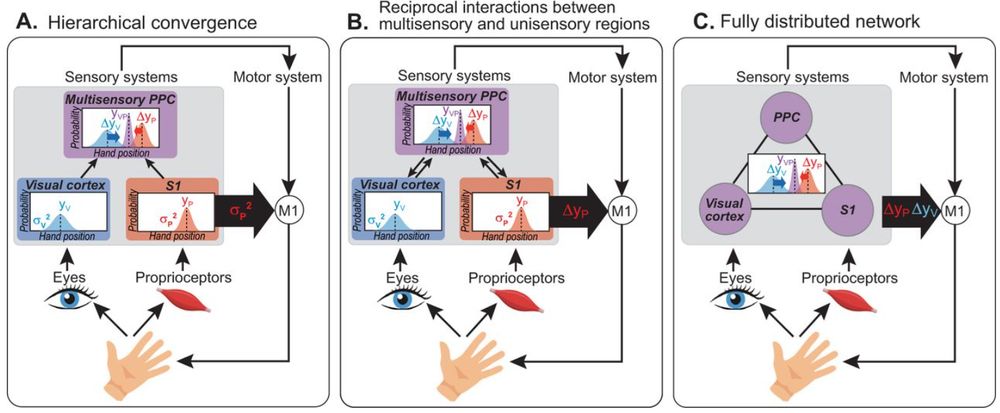
🚨It's published! 🚨Our results support highly-simplified-model "B", if you're wondering. The Somatosensory Cortex and Body Representation: Updating the Motor System during a Visuoproprioceptive Cue Conflict www.jneurosci.org/content/45/3...
11.08.2025 15:07 — 👍 6 🔁 4 💬 0 📌 0

What happens to motor adaptation—the way we correct errors with feedback—when feedback is indirect, like a number on a screen?
In our new paper in @royalsociety.org, we found that indirect feedback hinders learning compared to sensory feedback.
tinyurl.com/5d32c99e
30.07.2025 11:33 — 👍 24 🔁 5 💬 1 📌 0

Found it! Not significantly different from younger adults, but very small samples. And different method from yours. brill.com/view/journal...
28.05.2025 16:04 — 👍 1 🔁 0 💬 0 📌 0
Cool! I'll add this to my reading list. I'm curious how the weighted combination is calculated. I recall also noticing higher weight of vision in older people in a study a few years ago, although might not have been significantly different from young ppl.
28.05.2025 01:13 — 👍 1 🔁 0 💬 1 📌 0
 10.03.2025 18:58 — 👍 2 🔁 0 💬 0 📌 0
10.03.2025 18:58 — 👍 2 🔁 0 💬 0 📌 0

(5/5)... recalibration expected. As you can see, the control group pointed at the V cue throughout its gradual displacement (A). The lack of undershoot indicates subject laziness is not the cause of V cue undershoot when the real cue conflict is present. (positive values in B = V cue undershoot)
29.01.2025 19:54 — 👍 0 🔁 0 💬 0 📌 0
(4/5)...(a confound) rather than because they perceive the visual cue closer than it is (visual recalibration). So a control group performed the task with only unimodal visual cues during the "cue conflict". The V cue moved away at the usual rate, but there were no bimodal trials so no visual...
29.01.2025 19:54 — 👍 0 🔁 0 💬 1 📌 0

(3/5) Bonus expt: Is visual recalibration real? I get asked this because we do the cue conflict by gradually shifting the visual cue away from the proprioceptive cue. When subjects undershoot visual cues on unimodal trials (blue arrow), it could be because they're too lazy to point further away ...
29.01.2025 19:54 — 👍 0 🔁 0 💬 1 📌 0
(2/5) These updates are specific to the change in proprioceptive representation and are absent when cues are not in conflict. This may represent a unisensory pathway to the motor system that conveys information about hand representation, acting in parallel with multisensory pathways.
29.01.2025 19:54 — 👍 0 🔁 0 💬 1 📌 0

(1/5)📢Now with bonus experiment!📢Somatosensory cortex and body representation.
When hand representation is modified by introducing a conflict between visual and proprioceptive cues, the motor system receives updates directly from primary somatosensory cortex (SI). www.biorxiv.org/content/10.1...
29.01.2025 19:54 — 👍 9 🔁 2 💬 1 📌 0

📢New preprint! The brain may handle visuo-proprioceptive cue conflicts differently for a dynamic hand undergoing visuomotor adaptation than for a static hand. www.biorxiv.org/content/10.1...
02.10.2024 15:23 — 👍 8 🔁 1 💬 0 📌 0

Our lab is hiring a post-doc at Emory University, working on sensorimotor neuroimaging after stroke and/or multisensory integration, touch and embodiment. Start date: approximately late summer 2024. Please email me with any questions you have about the position.
23.01.2024 13:22 — 👍 8 🔁 12 💬 0 📌 1
Entertained by the neural control of skilled action. Assistant Professor | Dept. of Human Physiology | University of Oregon | https://pages.uoregon.edu/mmar/
https://www.engineering.pitt.edu/subsites/Labs/sml/
Brains, Data and Science
Prof in Computational Neuroscience at Western University
Cerebellum and Motor Control
Professor, Scientist and Engineer
How do we move? I study brains and machines at York University (Assistant Professor). Full-time human.
Neural Control & Computation Lab
www.ncclab.ca
Postdoctoral Motor Control Researcher in Neuroscience at Penn State | Leveraging Athletic Experience for Motor Learning Insights | Non‑invasive neural stimulation techniques to restore functional motor control of the hand
Distinguished Research Professor in Neuroscience; York Research Chair in Visuomotor Neuroscience; Director, Centre for Integrative and Applied Neuroscience; PI, Connected Minds Program, York University, Toronto 🍁
Sir Henry Wellcome Fellow at Imperial College London. Interested in balance, falls, anxiety, vestibular, healthy ageing. Board Member of ISPGR.
handy neuroscientist | touch & movement | brain stimulation | neurobiography.info | pod @theerrorbar.bsky.social theerrorbar.com | @tmsmultilab.bsky.social https://tms-rat.org https://tms-smart.info | b. 335ppm C💚2 | pro birds | Associating with Professors
Professor of biological psychology
@unigreifswald.bsky.social. Member @jungeakademie.bsky.social.
https://psychologie.uni-greifswald.de/43051/biologische-psychologie/prof-dr-jakub-limanowski/
associate prof at university of minnesota | masonic institute for the developing brain | brain networks & behavior lab PI | views my own | oberlin to iu to penn to iu to umn | https://www.brainnetworkslab.com/
Movement [Learning | Perception]
Research Associate at York University, Toronto
Cognitive psychologist interested in perception, illusions, sensorimotor control, and virtual reality.
I also blog for early-career academics: https://gavinbuckingham.wordpress.com/
Motor control neuroscientist, Jefferson Moss Rehab Research Institute. Motor planning, learning, and cognitive-motor interactions. https://www.jefferson.edu/academics/colleges-schools-institutes/skmc/departments/rehabilitation/faculty/wong.html (he/him) 🏳️🌈
Biomechanics professor at the University of Michigan interested in the biomechanics, energetics, and control of human locomotion
Assistant Professor and PI at Donders and Karolinska Institutes, leading the Somatosensation&Gargalesis lab (a.k.a Touch&Tickle lab). I study actions, touch, and tickles 🧠 (https://www.kiltenilab.org/). Ελληνίδα μάνα who cooks dolmadakia for friends.
Principal Research Scientist at Boston Fusion
Robots, VR and a cat
Head of Chaos at @vrsummit.bsky.social
https://vrs.rub.de
Sensorimotor neuroscientist and professor at York University.
https://deniseh.lab.yorku.ca/




 10.03.2025 18:58 — 👍 2 🔁 0 💬 0 📌 0
10.03.2025 18:58 — 👍 2 🔁 0 💬 0 📌 0




